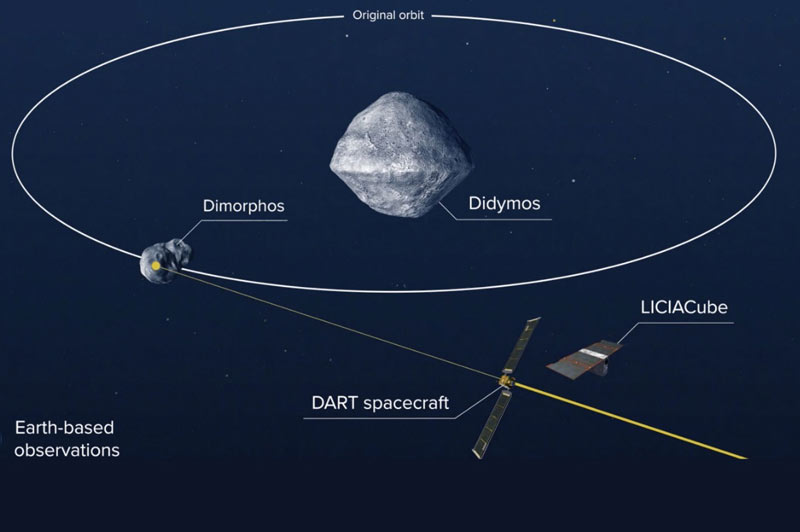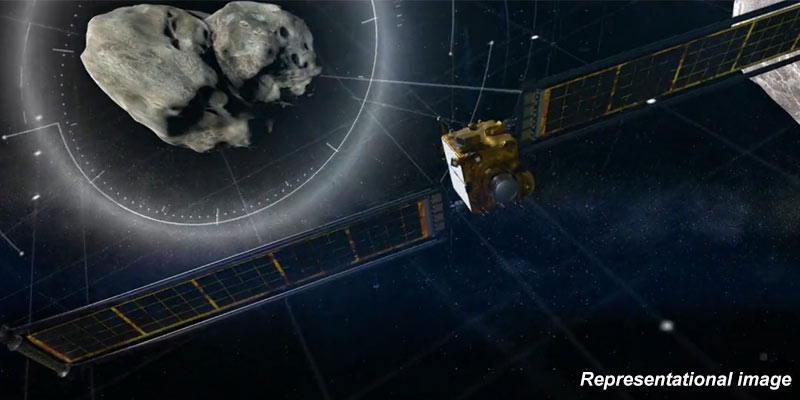- World
- Oct 12
DART mission succeeds in changing asteroid’s orbit
Analysis of data obtained over the past two weeks by NASA’s Double Asteroid Redirection Test (DART) investigation team shows the spacecraft’s kinetic impact with its target asteroid, Dimorphos, successfully altered the asteroid’s orbit.
This marks humanity’s first time purposely changing the motion of a celestial object and the first full-scale demonstration of asteroid deflection technology.
Double Asteroid Redirection Test (DART)
• NASA launched the Double Asteroid Redirection Test (DART mission) in November 2021 aboard a SpaceX Falcon 9 rocket. After 10 months flying in space, DART successfully impacted asteroid Dimorphos on September 26.
• DART is the first-ever mission dedicated to investigating and demonstrating one method of asteroid deflection by changing an asteroid’s motion in space through kinetic impact.
• The DART spacecraft was built and is operated by the Johns Hopkins Applied Physics Laboratory (APL) in Laurel, Maryland, at the direction of NASA’s Planetary Defense Coordination Office (PDCO).
DART targeted the asteroid moonlet Dimorphos, a small body just 530 feet (160 meters) in diameter. It orbits a larger, 2,560-foot (780-meter) asteroid called Didymos. Neither asteroid poses a threat to Earth.
• Didymos — which means “twin” in Greek — was discovered on April 11, 1996. The name is a loose description of the larger main body and the smaller orbiting moon. Dimorphos, which means “two forms”, reflects the status of this object as the first celestial body to have the ‘form’ of its orbit significantly changed by humanity. The Dimorphos moonlet is one of the smallest astronomical objects to receive a permanent name and is one of 27,500 known near-Earth asteroids of all sizes tracked by NASA.
• The spacecraft’s sole instrument, the Didymos Reconnaissance and Asteroid Camera for Optical navigation (DRACO), together with a sophisticated guidance, navigation and control system that works in tandem with Small-body Maneuvering Autonomous Real Time Navigation (SMART Nav) algorithms, enabled DART to identify and distinguish between the two asteroids, targeting the smaller body.
• These systems guided the 570-kilogram box-shaped spacecraft through the final 90,000 kilometers of space into Dimorphos, intentionally crashing into it at roughly 22,530 kilometers per hour to slightly slow the asteroid’s orbital speed.
The impact changed asteroid’s motion in space
• Prior to DART’s impact, it took Dimorphos 11 hours and 55 minutes to orbit its larger parent asteroid, Didymos. Since DART’s intentional collision with Dimorphos on September 26, astronomers have been using telescopes on Earth to measure how much that time has changed.
• Now, the investigation team has confirmed the spacecraft’s impact altered Dimorphos’ orbit around Didymos by 32 minutes, shortening the 11 hour and 55-minute orbit to 11 hours and 23 minutes. This measurement has a margin of uncertainty of approximately plus or minus 2 minutes.
• Before its encounter, NASA had defined a minimum successful orbit period change of Dimorphos as change of 73 seconds or more. This early data show DART surpassed this minimum benchmark by more than 25 times.
• Focus now is shifting toward measuring the efficiency of momentum transfer from DART’s roughly 22,530 kmph collision with its target. This includes further analysis of the “ejecta” – the many tonnes of asteroidal rock displaced and launched into space by the impact. The recoil from this blast of debris substantially enhanced DART’s push against Dimorphos – a little like a jet of air streaming out of a balloon sends the balloon in the opposite direction.
• To successfully understand the effect of the recoil from the ejecta, more information on the asteroid’s physical properties, such as the characteristics of its surface, and how strong or weak it is, is needed. These issues are still being investigated.
The importance of planetary defence
• Near-Earth objects (NEOs) are asteroids and comets that orbit the Sun like the planets, but their orbits can bring them into Earth’s neighborhood — within 30 million miles of Earth’s orbit.
• On February 15, 2013, an undetected asteroid entered Earth’s atmosphere and exploded over Chelyabinsk in Russia, causing an airburst and shockwave that struck six cities around the region. The blast injured more than 1,600 people and caused an estimated $30 million in damage. It was a stark reminder that potentially hazardous objects can enter Earth’s atmosphere at any time, and that even relatively small ones can be of concern. The Chelyabinsk object was just about 60 feet (18 meters) in size.
• Astronomers estimate that there are approximately 25,000 near-Earth asteroids close to 500 feet (140 meters) or larger in size — big enough to cause regional devastation if they were to hit Earth. This underscores the need to both discover and track near-Earth objects, as well as perform real-world tests of potential asteroid deflection.
• Asteroids, like Earth and the other planets, orbit the Sun, but they become hazardous only if their orbits and Earth’s orbit intersect at the same point and time. The key to preventing an impact is the ability to predict such mutual arrivals well in advance, then alter the asteroid’s path, even slightly, to make the asteroid arrive early or late, missing a collision with Earth.
• Planetary defence encompasses all the capabilities needed to detect and warn of potential asteroid or comet impacts with Earth, and either prevent them or mitigate their possible effects.
• NASA’s Planetary Defence provides early detection of potentially hazardous objects (PHOs) – the subset of NEOs whose orbits predict they will come within 5 million miles of Earth’s orbit, and of a size large enough (30 to 50 meters) to damage Earth’s surface.
Manorama Yearbook app is now available on Google Play Store and iOS App Store




